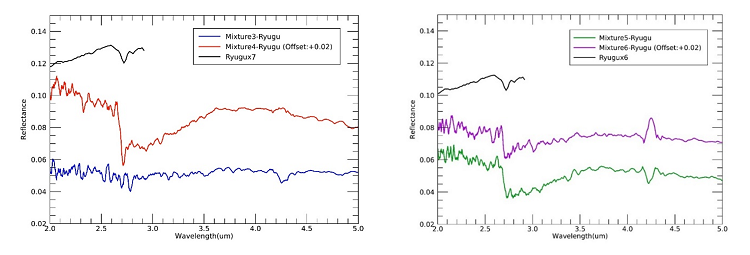VIS-NIR reflectance analysis of (162173) Ryugu analogues mixtures and CC meteorites in the framework of Hayabusa2 mission
- INAF-IAPS, Rome, Italy (fabrizio.dirri@inaf.it)
1. Introduction
Hayabusa2 – Japanese Aerospace Exploration Agency Mission investigated the asteroid (162173) Ryugu and on 06 December 2020 successfully returned to the Earth ~5.4 g of collected materials. Indeed, the first touch-down operation (TD1) sampled surface material on 21st February 2019; after the formation of a 15 m artificial crater with the SCI operation (Saiki et al., 2013), the TD2 occurred on 11st July 2019 and collected samples in the vicinity of crater, probably also subsurface material excavated by the impact. Ryugu appears to be a rubble-pile asteroid due to the low density (about 1.2 g/cm3) which suggests a formation by re-accumulation of fragments generated by the catastrophic destruction of the parent body (Watanabe et al., 2019). NIRS3 spectra of Ryugu surface acquired during Hayabusa2 mission show a strong features at 2.7 μm (indicating a OH-rich content ascribed to Mg-rich phyllosilicates) (Kitazato et al., 2019) and a secondary absorption at about 2.8 μm, strongly correlated with the 2.7 μm band (Galiano et al., 2020).
This work includes the Carbonaceous Chondrite meteorites (CCs) identification and selection in grains from ~1 to 4mm to simulate the Ryugu surface and analogue mixtures production by using different end-members: a dark component (graphite, carbon, etc.), Mg-rich phyllosilicates (i.e. Antigorite for OH stretching band at 2.7 μm) and Fe-rich dark component (e.g. Cronstedtite) to reproduce the 0.7 and 2.8 μm bands of Fe-bearing phyllosilicates. Four analogue mixtures have been sieved in the grain size 100-200 μm and 200-300 μm and named: Mixture#3, Mixture#4, Mixture#5 and Mixture#6. The spectra of the samples have been acquired by means of Bruker Vertex 80 FT-IR Spectrometer (incidence angle of 30° and emission angle of 0°) in the spectral range 2-4 μm (spectral resolution of 4 cm-1) and then compared with average Ryugu spectrum. The spectral slope (in the 2.0-2.5 μm range), Band Depth and Band Center of the feature at 2.7μm and reflectance at 2.1μm have been analysed.
2. CCs meteorites analysis
The acquired meteorites spectra (fragments) compared with Ryugu ones are reported in Figure 1. The results show as the reflectance (at 2.1μm) values of meteorites (0.042 Murray, 0.032 Nagoya and 0.030 Nagoya) can be comparable with Ryugu reflectance level, i.e. 0.0296 as well as the BC (2.731 Murray, 2.749 Nagoya and 2.716 Nagoya and 2.719 of Ryugu spectra). Differently, the meteorites BD is from four to eight times more intense than Ryugu one.

Figure 1. Meteorites spectra and comparison with Ryugu (smoothed with 61 channels).
3. Analogue mixtures analysis
The analogue mixtures (about 0.1g) have been produced by considering the grain size of 100-200 µm and 200-300 µm (Figure 2). Each end-member has been analysed in the spectral range of interest, for example the Antigorite shows the bands at 2.3 µm (due to combination of Mg-O-H bending and O-H stretching) and at 2.7 µm (O-H stretching).
Figure 2. Percentage composition of Ryugu analogue mixtures.
The Figure 3 at left shows the spectra of Mixture #3 and #4 while at right the Mixture #5 and #6 compared with the mean spectrum of Ryugu (obtained by NIRS3 data) multiplied by 7 for a better comparison. The Mixture#3 does not show the contribution of OH bands due to high percentage of dark component, i.e. 42.5%. Thus, the Mixture#4 has been produced by increasing the Mg-rich phyllosilicates, reducing the dark component and introduce the Cronstedtite (Fe- bearing phyllosilicate). So that, it is important to introduce an additional dark component, i.e. the Cronstedtite (Fe- bearing phyllosilicate) which can help to decrease the reflectance level and to contribute to shallow 2.7 µm band due to OH.

Figure 3. Analogue mixtures compared with average Ryugu spectrum.
4. Preliminary results and future aims
The mixtures #4, #5, #6 showed a negative spectral slope due to the high percentage of Antigorite (up to 60%) responsible of the 2.7 μm band while 3 μm spectral band has been ascribed to the adsorbed atmospheric water. Furthermore, the Cronstedtite included in the Mixture#6 gave a contribution to the dark component equal to 32.5% by avoiding negative effects on 2.7 μm spectral band that remains to be well defined. Preliminary analysis exhibit a good comparison between Ryugu BC and analogue mixtures BC (due to the presence of Mg-phyllosilicate) whereas the BD in spectra of analogue mixtures is deeper than the Ryugu one. The Ryugu reflectance is two-three times lower than the mixtures reflectance and characterized by a positive spectral slope, contrarily to the mixtures’ spectra which have a negative spectral slope. Starting from Mixture#6, next step will aim at reducing the reflectance level and decrease the OH band contribution, as well as producing a positive spectral slope. By using thermal controlled setup in vacuum chamber at different temperatures (e.g. 100, 200, 300, 400°C), a thermal metamorphism can be simulated and new spectra will be acquired. In the future, laser and ion irradiations can be considered to simulate the micrometeorite impacts and solar wind processes which help to decrease the spectral level and increase the spectral slope, as well as to reduce the analogue mixtures spectral bands.
References: Galiano A., et. al. 2020, Icarus, v. 351, 113959; Kitazato, K. et al. 2019, Science 364, 6437: 272-275; Saiki, T., et al. 2013, Acta Astronautica, v. 84, 227-236; Tatsumi, E. et. al., 2021, Nat Commun 12, 5837; Watanabe, S. et al., 2019, Science 364, 6437: 268-272
How to cite: Dirri, F., Palomba, E., Galiano, A., Longobardo, A., Gisellu, C., and Angrisani, M.: VIS-NIR reflectance analysis of (162173) Ryugu analogues mixtures and CC meteorites in the framework of Hayabusa2 mission, Europlanet Science Congress 2022, Granada, Spain, 18–23 Sep 2022, EPSC2022-154, https://doi.org/10.5194/epsc2022-154, 2022.

